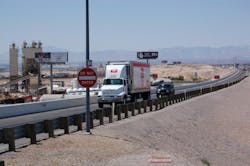It’s one of the aggravating realities of trucking that no matter how many mandates and regulations get slapped upon commercial vehicles and their hard-working drivers, at the end of the day, they must share the road with thousand of folks to whom those rules don’t apply – no matter that their behavior behind the wheel has as much, if not more, impact on highway safety as big rigs.
Take the whole issue of texting while driving, for starters. The Federal Motor Carrier Safety Administration (FMCSA), as we all know, put rules in place that forbid drivers of both commercial trucks and buses from texting while operating their vehicles, with stiff penalties for any infractions.Yet those rules don’t apply to the millions of four-wheelers out there plying the same roads truckers do – and they are the ones, believe it or not, that are responsible for the majority of fatal truck-car collisions.
FMCSA’s own crash research backs this up, showing that in fatal crashes where a “driver-related” factor is recorded, that factor is assigned to the driver of a passenger vehicle 80.5% of the time.
On top of that, the majority of fatal multi-vehicle crashes (59%) recorded in FMCSA's truck-car collision database resulted from a passenger vehicle rear-ending a truck, crossing the median and hitting a truck head on, or hitting a truck in some other way; less than 40% of such accidents resulted from a truck striking a car.
Yet only a handful of states have put laws on the books restricting cell phone use and texting while behind the wheel for everyday drivers – despite surveys that show many four wheelers, but especially teenagers, engage in such “distracted driving” behaviors on a widespread basis.
Take a new survey commissioned by AT&T as part of the new It Can Wait campaign: it indicates that while 97% of teens know texting while driving is dangerous, 43% of them freely admit to sending a text while driving – with 75% saying the practice is “common” among their friends.
The survey found that teenagers feel pressure to quickly respond to text messages – and adults are also setting a poor example by texting while driving themselves, AT&T found.
Here are some other worrying findings from this poll:
- Peer pressure: Almost all teens (89%) expect a reply to a text or email within five minutes or less.
- Knowledge but little action: 75% of teens say texting while driving is “very” dangerous – but 43% admit to doing so.
- "Gateway" dangers abound: 70% of teens believe texting while stopped at a red light is dangerous.
- Still, 60% of teens admit to texting at a red light and 73 percent admit to glancing at their phone at a red light. A further 61% of teens say they glance at their phone while driving, and 61% have seen their friends read or send an email, or text, while driving.
- Learning by example: According to 77% of teens, adults tell kids not to text while driving – yet adults do it themselves “all the time,” with 41% of teens report seeing their parents read or send an email, or text, while driving. Yet 62% of teens feel that getting reminders from their own parents not to text and drive would be effective in getting them or their friends to stop texting and driving.
For example, distracted driving — specifically cell phone use and texting — remains a widespread problem, even though 94% of drivers consider texting while driving a serious threat, according to the group’s annual Traffic Safety Culture Index.
Yet more than one-third of drivers (35%) in AAA's poll admit to reading a text or email while driving in the past 30 days, and more than a quarter of drivers (26%) admit to sending a message while driving in the past month. Also, more than two-thirds of drivers (68%) report talking on their cell phone while driving in the past month, and nearly one in three (31%) say they do so fairly often or regularly.
“Such findings indicate that a false [sense of] comfort exists among many drivers who believe ‘it is the other guy behind the wheel’ yet admit to regularly engaging in potentially deadly behaviors like texting, driving while drunk or drowsy, excessive speeding, and red light running,” noted Peter Kissinger, AAA Foundation’s president.
The issue of “distracted driving” shouldn’t be taken lightly, either, as research by the National Highway Traffic Safety Administration (NHTSA) determined that, in 2010, an estimated 3,092 people died in distraction-affected crashes.
Chew on these two factoids as well: On average, teens text five times more per day compared to a typical adult and, when this habit hits the road, drivers who text are 23 times more likely to be in an accident or near-accident. These are drivers, of course, “hitting the road” right alongside tractor-trailers whose operators are forbidden by law to engage in such behavior.
The upshot of all of this is pretty simple: if we really, truly, want to improve highway safety, we’ve got to extend some of the same “behavior bans” governing the trucking industry to the entire motor vehicle operating populace.
We all use the same roads; thus, it’s well past time that we should all be governed by the same rules.


